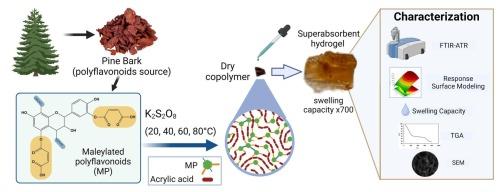用松皮马来酸聚黄酮类化合物与丙烯酸共聚制备高吸水性水凝胶
IF 6.3
2区 化学
Q1 POLYMER SCIENCE
引用次数: 0
摘要
本研究以松皮马来酸多黄酮为原料,采用自由基聚合的方法合成丙烯酸。研究了不同组分摩尔比和不同反应温度下的共聚反应。结果表明,反应温度从20℃提高到80℃,转化率提高,胶凝时间加快。在62℃、聚黄酮与丙烯酸的摩尔比为1.125的条件下,得到了转化率最高的共聚物。共聚物的溶胀度受温度和组分摩尔比的影响较大,范围在1000% ~ 770%之间。在80℃条件下合成的聚类黄酮与丙烯酸的比例为0.25,共聚物的溶胀度最高可达7000 %。本研究的结果表明,通过调整不同的反应参数,可以设计出具有特定形态和膨胀能力的材料。此外,研究表明,马来酸多黄酮可作为生物基化合物在工业路线上与生产高吸水性材料有关。本文章由计算机程序翻译,如有差异,请以英文原文为准。

Superabsorbent hydrogel preparation by copolymerization of pine bark maleilated polyflavonoids with acrylic acid
In this work, maleilated polyflavonoids from pine bark were used as renewable building blocks in the free radical polymerization route of acrylic acid. The copolymerization reaction under different molar ratios of components and different reaction temperatures was studied. It was shown that an increase in reaction temperature from 20 to 80 ℃ increased the conversion degree and accelerated the gelation time. The copolymers with maximum conversion degree were obtained at 62 ℃ and polyflavonoid:acrylic acid molar ratio 1.125. The swelling degree of copolymers strongly depended on temperature and molar ratio of components and ranged between 1000% and 7000 %. The highest swelling degree of 7000 % was obtained for the copolymers synthesized at 80 ℃ and polyflavonoid:acrylic acid with a ratio of 0.25. The results presented in this work imply that it is possible to design the materials with specific morphology and swelling ability by tuning the different reaction parameters. Moreover, it is shown that maleilated polyflavonoids might be used as biobased compounds in industrial routes associated with production of superabsorbent materials.
求助全文
通过发布文献求助,成功后即可免费获取论文全文。
去求助
来源期刊

European Polymer Journal
化学-高分子科学
CiteScore
9.90
自引率
10.00%
发文量
691
审稿时长
23 days
期刊介绍:
European Polymer Journal is dedicated to publishing work on fundamental and applied polymer chemistry and macromolecular materials. The journal covers all aspects of polymer synthesis, including polymerization mechanisms and chemical functional transformations, with a focus on novel polymers and the relationships between molecular structure and polymer properties. In addition, we welcome submissions on bio-based or renewable polymers, stimuli-responsive systems and polymer bio-hybrids. European Polymer Journal also publishes research on the biomedical application of polymers, including drug delivery and regenerative medicine. The main scope is covered but not limited to the following core research areas:
Polymer synthesis and functionalization
• Novel synthetic routes for polymerization, functional modification, controlled/living polymerization and precision polymers.
Stimuli-responsive polymers
• Including shape memory and self-healing polymers.
Supramolecular polymers and self-assembly
• Molecular recognition and higher order polymer structures.
Renewable and sustainable polymers
• Bio-based, biodegradable and anti-microbial polymers and polymeric bio-nanocomposites.
Polymers at interfaces and surfaces
• Chemistry and engineering of surfaces with biological relevance, including patterning, antifouling polymers and polymers for membrane applications.
Biomedical applications and nanomedicine
• Polymers for regenerative medicine, drug delivery molecular release and gene therapy
The scope of European Polymer Journal no longer includes Polymer Physics.
 求助内容:
求助内容: 应助结果提醒方式:
应助结果提醒方式:


